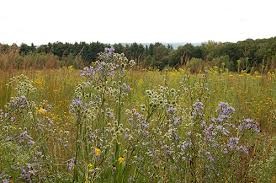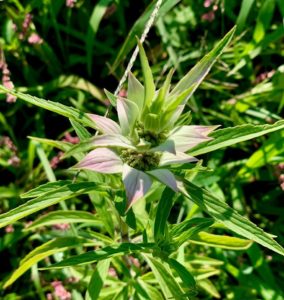
By Elizabeth Garrett
The calendar tells me that summer is flying by. Yet the warm weather and pace of a vacation day can lull me into believing that the drawn-out lazy days will go on forever. But the insects, plants, and birds know better. Anyone who is lucky enough to take a long walk along a country road or through a meadow will notice much activity as bees, butterflies, and bugs of all sorts are busy making the most of the hot weather.
Things are no different at Jay Heritage. But few of us get a chance to take a leisurely walk through the meadow and even fewer take the time to really look and notice what is happening. Then, of course, there is the added challenge of even knowing what to look for.Most of our members know that the native meadow restoration project is in full swing. But restoration is a process and to an untrained eye, it’s not always clear where along that road we stand.
Last week, I had the pleasure of walking the Jay meadow with two professionals who know exactly what to look for. Our new Executive Director Kevin Peraino, President of the Board of Directors Suzanne Clary, fellow board member Lucy Berkoff, and I walked the meadow with Larry Weaner and one of his team members, Marli Milano. Being a gardener myself, the first thing I noticed were the weeds. And since I have been on site recently, I also immediately noticed the extraordinary growth of the nurse crop planted as a “place holder” to keep invasives at bay this first year as baby perennial plants get started. These less-encouraging signs worried me.
But Larry and Marli were able to look beyond all the unwelcome growth and use their training to assess the plants in greater depth and detail. Their eyes were looking for two important indicators. First, they assessed seed germination. Then they looked for weeds that would inhibit the seedlings from thriving by crowding them or shading them. All weeds are not created equal. I was immediately humbled by Larry’s uncanny ability to identify the smallest seedlings, some of which did not look that different from ordinary grass. As he began to point out the first-year growth of perennials I thought I was familiar with, I realized that my eye was used to seeing three and four-year-old plants, separated and identified as important in their black one gallon containers, sitting in the native section of a local nursery. As a further aid, they have their Latin names in bold type across a label with a close-up picture of the flower in full bloom. Under those circumstances, it’s easy to think yourself an expert. But as Larry rattled off familiar names, he pointed out very unfamiliar (and tiny) plants. He was right when he said “the more you slow down and look, the more you see.” Once he pointed out the spotted mint there and the partridge pea here, the more we all were able to see beyond the smartweed. Soon we were all squealing like kids at an egg hunt: “Here’s a partridge pea” and “I’ve got foxtail over here.” We saw native sedges, butterfly weed, coreopsis, spiderwort, and golden Alexander. Yes, there is mugwort, and that concerns me. But there are also seedlings that will form the backbone of the meadow for years to come. And that was most encouraging.
He recommended that the meadow be mown shorter than usual just now in an attempt to control the smartweed, which can mat and keep the planted seedlings from getting the sun they need. In August we will go back to keeping the height in the 4”-6” range and maintain that through the fall. All are encouraged to walk and look closely and see the insect activity and try to find the seedling jewels scattered throughout the meadow. Slowing down, looking closely, and feeling the warm breeze in your face, you just might feel like summer is here to stay.


